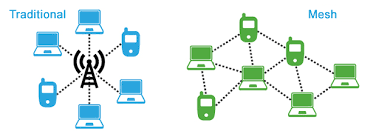Mesh Network Defined
“ A mesh network (or simply meshnet) is a local network topology in which the infrastructure nodes (i.e. bridges, switches, and other infrastructure devices) connect directly, dynamically and non-hierarchically to as many other nodes as possible and cooperate with one another to efficiently route data from/to clients.”
—— Wikipedia
Mesh Network vs Traditional Networks
Mesh networks connect the infrastructure nodes in an easy, effective and wireless way, using inexpensive, existing technology. It makes every object into IoT become possible.
Traditional networks connect users and devices counting on a small number of wired access points or wireless hotspots. In the wireless mesh network, the network connection stretches among dozens or hundreds of wireless mesh nodes that communicate to each other to share the network connection across a large area.
Mesh works in a different way. There’s no central hub,switch or computer which handles all computer traffic. Instead,each device on the mesh network cantalk to every other device. It uses a particular kind of protocol for moving information from one place to another. These multiple relays can quickly direct traffic across devices. This creates a mesh-like pattern of connectivity.
Why Mesh Networks?
Mesh network realizes wireless literally and seamless connection. Its own advantages make it extremely competitive. Advantages include:
▷ Cost Effective. Fewer wires in large areas of coverage can save more costs.
▷ Faster Connection & Running. The more nodes you install, the bigger and faster your wireless network becomes. And wireless mesh configurations allow local networks to run faster, because local packets don’t have to travel back to a central server.
▷ Wide Suitability. They rely on the same WiFi standards (802.11a, b and g) already in place for most wireless networks.
▷ High Reliability. When wireless signals are intermittently blocked, the mesh network will adjust to find a clear signal.
▷ Smarter. Mesh networks can automatically integrate a new node into the existing structure without any adjustments by a network administrator. And it would find the fastest and most reliable paths to send data, even if nodes are blocked or lose their signal.
▷ Easy Scalability. Mesh networks don’t require additional routers. Instead, each node acts as router instead. This means you can quickly and easily change the size of the network, making the network extremely adaptable and expandable.
Applications
Combined the Bluetooth Low Energy (BLE) technology with the mesh networking, BLE mesh networking allows for many-to-many communication over Bluetooth radio, achieving multiple applications where employ Bluetooth tech.
In conclusion, mesh networks are an ideal infrastructure for IoT projects, as they provide additional flexibility by allowing them to operate regardless of broken paths or faulty devices. Mesh network is bound to become more and more practical, completely making IoT era march forward. The future applications for wireless mesh networks are limited only by our imaginations. Minew invites you to explore the next.



 Chat now
Chat now
